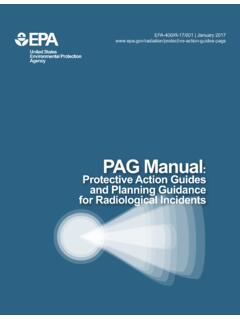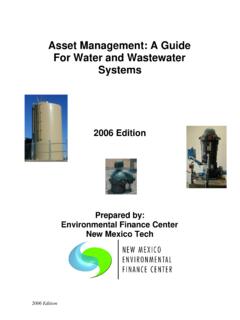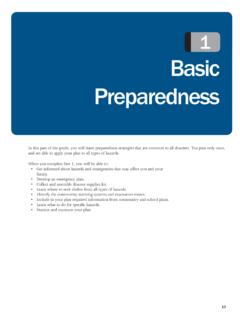Transcription of Emergency Water Supply Planning Guide for Hospitals and ...
1 1 Emergency Water Supply Planning Guide for Hospitals and Healthcare Facilities2 Note for accessibility:Complete explanations of figures with titles are in Appendix citationCenters for Disease Control and Prevention and American Water Works Association. Emergency Water Supply Planning Guide for Hospitals and Healthcare Facilities. Atlanta: Department of Health and Human Services; 2012. Updated findings and conclusions in this report are those of the author(s) and do not necessarily represent the views of their agencies or organizations. The use of trade names is for identification only and does not imply endorsement by authoring agencies or organizations. American Water Works Association Centers for Disease Control and PreventionEnvironmental Protection Agency4 Contents1. Abbreviations and Acronyms ..62. Executive Introduction ..84. Overview of Plan Development Process ..9 Step 1: Assemble the facility s EWSP team and the necessary background documents.
2 9 Step 2: Understand Water usage through a Water use audit ..9 Step 3: Analyze your Emergency Water Supply alternatives ..9 Step 4: Develop and Exercise Your EWSP ..95. Step 1: Assemble the facility s EWSP team and the necessary background documents ..106. Step 2: Understand Water usage through a Water use audit .. Water Use Audit Work Plan .. Phase 1: Determine Water Usage under Normal Operating Conditions .. Phase 2: Identify Essential Functions and Minimum Water Needs .. Phase 3: Identify Emergency Water Conservation Measures .. Phase 5: Develop Emergency Water Restriction Plan .. Phase 4: Identify Emergency Water Supply Options ..147. Step 3: Analyze your Emergency Water Supply alternatives .. Overview and Initial Decision Making .. Storage Tanks .. Other Nearby Water Sources .. Tanker-transported Water .. Large Temporary Storage Tanks (Greater than 55 Gallons) .. Water Storage Containers (55 Gallons and Smaller) .. Water Storage Location and Rotation.
3 Contaminant Considerations and Treatment Options ..358. Step 4: Develop and exercise your EWSP ..439. Conclusion ..4310. References ..4411. Bibliography ..4512. Appendices ..47 Appendix A: Case Studies ..48 Appendix B: Example Plan ..50 Appendix C: Loss-of- Water -Scenario ..53 Appendix D: Example Water Use Audit Forms 1 and 2 ..58 Appendix E: Portable Water Flow Meters ..60 Appendix F: Dialysis Considerations ..61 Appendix G: Explanations of Figures for Accessibility ..63 Appendix H: Acknowledgments ..665 List of tablesTable Some Typical Water Usage Functions/Services ..12 Table Draft List of Healthcare Functions and Water Needs ..13 Table Example of Emergency Water Storage and Usage Estimates ..18 Table Bladder and Pillow Tank Sizes ..28 Table Onion Tank Sizes ..29 Table Pickup Truck Tank Sizes ..29 Table Approximate Weight of Water -filled Containers ..33 Table Microbial Removal Achieved by Available Filtration Technologies ..37 Table B-1.
4 Estimated Reservoir Operational Duration ..51 List of figuresFigure 1. Developing an Emergency Water Supply Plan (EWSP) ..9 Figure Alternative Water Supplies Overview ..16 Figure Alternative Water Supplies Storage Tanks ..19 Figure Alternative Water Supplies Nearby Sources (From Figure ) ..22 Figure Alternative Water Supplies Other Nearby Public Water Supply Sources ..23 Figure Alternative Water Supplies Nearby Sources Surface Water ..24 Figure Alternative Water Supplies Tanker-Transported Water ..27 Figure Alternative Water Supplies Bladders And Other Storage Units ..30 Figure Alternative Water Supplies Bladders And Other Storage Units For Non-Potable Uses ..31 Figure Bladder Tanks ..32 Figure Pillow Tanks ..32 Figure Pickup Truck Tank ..32 Figure Onion Water Tank With Removable Cover ..32 Figure 55-Gallon Water Drum ..34 Figure Hand Pump ..34 Figure 3- And 5-Gallon Containers ..34 Figure Alternative Water Supplies Portable Treatment Units Overview.
5 38 Figure Alternative Water Supplies Portable Treatment Units For Surface Water Source ..39 Figure Alternative Water Supplies Disinfection Of Surface Water ..40 Figure Alternative Water Supplies Portable Treatment Units For Groundwater Source ..41 Figure Alternative Water Supplies Portable Treatment Units For Nearby Water Source ..4261. Abbreviations and AcronymsAbbreviations and AcronymsDefinitionAAMIA merican Association for the Advancement of Medical InstrumentationACFA cute Care FacilityANSI/NSFA merican National Standards Institute/ National Sanitation FoundationASHEA merican Society for Healthcare EngineeringAWWAA merican Water Works AssociationCDCC enters for Disease Control and PreventionCFRCode of Federal Regulationscmcentimeter(s)CMSC enters for Medicare & Medicaid ServicesCTconcentration X timeDHHSD epartment of Health and Human ServicesDHSD epartment of Homeland of Natural ResourcesDWTU drinking Water treatment unitEDEmergency DepartmentEOPemergency operations planE Environmental Protection AgencyEWSP Emergency Water Supply planFACfree available chlorineFDAFood and Drug AdministrationFEMAF ederal Emergency Management (s)
6 Gpdgallons per daygpfgallons per flushgpmgallons per minuteGWRG roundwater RuleHAhealth advisoryhazmathazardous materialAbbreviations and AcronymsDefinitionHDLP high-density linear polyethyleneHDPE high-density polyethyleneHIV/AIDSH uman Immunodeficiency Virus/ Acquired Immune Deficiency SyndromeHVAC heating, ventilating, and air conditioningICSI ncident Command SystemICUI ntensive Care UnitImp gallon(s)ITintensity X timeMCLM aximum Contaminant LevelMCLGM aximum Contaminant Level GoalMGmillion gallon(s)MGDmillion gallon(s) per daymg/Lmilligrams per literMOUM emorandum of UnderstandingMRIM agnetic Resonance ImagingMTBE methyl tertiary butyl etherNICUN eonatal Intensive Care UnitNSF/ANSIN ational Sanitation Foundation/ American National Standards InstituteNTUnephelometric turbidity unitPETE polyethylene terephthalatePOU/POEpoint of use/point of entryROreverse osmosisTTtreatment techniquewUS gallon(s)UVultravioletuw/secultrawatt per secondVOCvolatile organic chemical72.
7 Executive SummaryIn order to maintain daily operations and patient care services, healthcare facilities need to develop an Emergency Water Supply Plan (EWSP) to prepare for, respond to, and recover from a total or partial interruption of the facility s normal Water Supply . Water Supply interruption can be caused by several types of events such as a natural disaster, a failure of the community Water system, construction damage, or even an act of terrorism. Because Water supplies can and do fail, it is imperative to understand and address how patient safety, quality of care, and the operations of your facility will be impacted. Below are a few examples of critical Water usage in a healthcare facility that could be impacted by a Water interruption or outage. They are divided into two categories developed by the Standards of the Joint Commission (Standard ) and the Centers for Medicare & Medicaid Services (CMS) Conditions for Participation/Conditions for Coverage (42 CFR ), which require Hospitals to address the provision of Water as part of the facility s Emergency Operations Plan (EOP) under Standard Standard requires Hospitals to identify alternative means of providing Water needed for consumption and essential care activities, and Water needed for equipment and sanitary Consumption and essential care activities handwashing drinking at faucets and fountains food preparation patient care fire suppression sprinkler systems2.
8 Equipment and sanitary purposes flushing toilets bathing patients laundry reprocessing of medical equipment medical specialties that use Water ( , dialysis) Water -cooled medical gas and suction compressors heating, ventilation, and air conditioning decontamination/hazmat response IT equipment coolingA healthcare facility must be able to respond to and recover from a Water Supply interruption to ensure patient safety. A robust EWSP can provide a road map for response and recovery by providing the guidance to assess Water usage, response capabilities, and Water Emergency Water Supply Planning Guide for Hospitals and Healthcare Facilities provides a four step process for the development of an EWSP:1. Assemble the appropriate EWSP team and necessary background documents for your Understand your Water usage by performing a Water use Analyze your Emergency Water Supply alternatives. 4. Develop and exercise your EWSP. The EWSP development process will vary from facility to facility.
9 For a small facility, one or two people might develop a basic EWSP consisting of only a few pages. For a large, regional hospital, multiple parties typically need to be involved to develop a more complex plan. Regardless of size, every healthcare facility must develop a robust EWSP to ensure patient safety and quality of care in the midst of a Water Emergency . This updated version incorporates changes to address feedback and lessons learned from recent Water outages in healthcare facilities. Updated sections include: The development of a convenient, succinct, and visually appealing companion to the EWSP Guide the Grab-and-Go Summary that provides a broad overview of the content. Edits to the EWSP Guide to: Improve readability and decrease redundancies Provide more information about Water contamination and contamination events that cause Water interruptions Include information on the importance of coordinating with stakeholders, such as local authorities and Water management groups Discuss Water management plans to reduce microbiological growth Considerations from recent healthcare Water emergencies The addition of the following: Dialysis Considerations Appendix83.
10 IntroductionHealthcare facilities are integral to the health and well-being of the communities they serve. The resilience of a community depends on the ability of its critical infrastructure sectors to reliably respond to its needs, particularly during Emergency events. Healthcare facilities make up an essential component of this critical infrastructure and must consistently maintain their Water capabilities to meet the needs of their community members. A National Infrastructure Advisory Council (NIAC) Report on Water Sector Resilience identified that healthcare capabilities are degraded 67% - 99% within two hours of Water service loss and other community capabilities such as electrical generation, critical manufacturing, and agriculture and food are degraded 67% - 99% within 4 hours of Water service loss. To ensure that their critical Water Supply is not compromised by a partial or total interruption in the municipal Water Supply , it is essential for every healthcare facility to develop and implement an effective Emergency Water Supply Plan (EWSP).

















